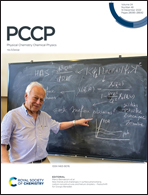Simulation of charge-transfer, UV-VIS and resonance Raman spectra of push–pull systems: a TDDFT and CASPT2 comparison†
Abstract
Time-Dependent Density-Functional Theory (TDDFT) and Extended Multi-State Complete Active Space Second-Order Perturbation Theory (XMS-CASPT2) methods, together with augmented correlation-consistent polarizable valence double-ζ (aug-cc-pVDZ) basis sets, were applied to simulate the vibronic and resonance Raman (RR) spectra of a push–pull model system, 4-nitroaniline (pNA) and its anion ([pNA]−), within the Independent Mode Displaced Harmonic Oscillator (IMDHO) model. Both methods predict adequately well the vertical absorption spectra for both species and the well-known charge-transfer (CT; S11(ππ*)) excited state of pNA. Nevertheless, pNA and [pNA]− absorption spectral band intensity and vibronic broadening are better reproduced at the XMS-CASPT2 level. RR spectra were also obtained using both methods, with a good agreement for both methods for pNA, for which the electronic wave functions are best described by a single state configuration. For the anion, for which the excited state presented a multiconfigurational nature, the TDDFT failed to predict the main intensification observed experimentally under resonance conditions. As to the resonance Raman excitation profile for the pNA species, the νS(NO2) vibrational mode carries most of the intensity of the vibronic spectrum, but for [pNA]− the contributions of main vibrational modes are more complex, being governed by different modes in different energies, with ring modes dominating at the maximum, as predicted by the XMS-CASPT2 method.



 Please wait while we load your content...
Please wait while we load your content...